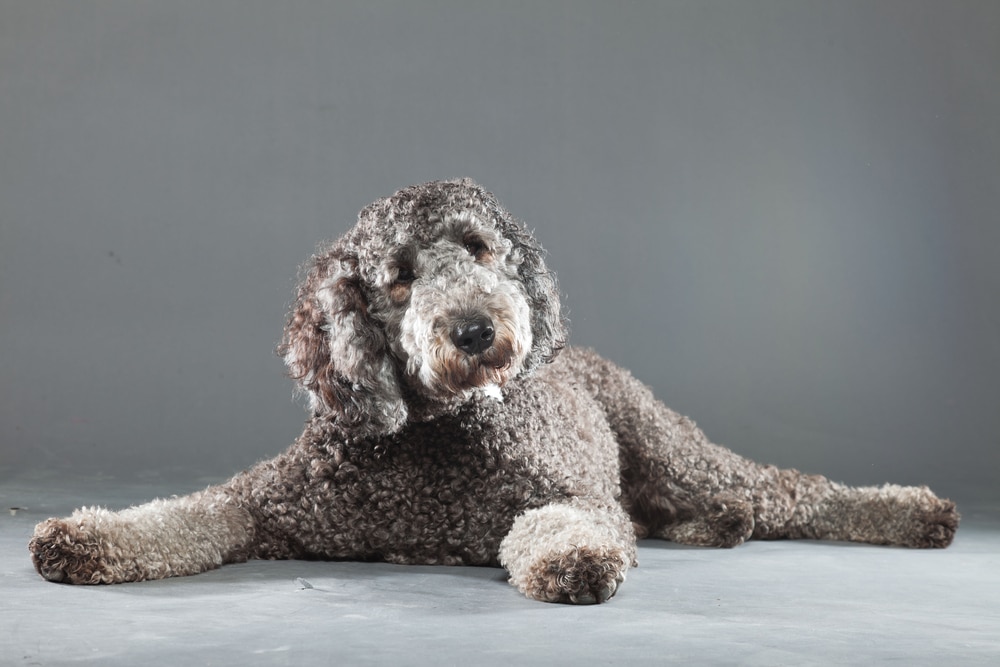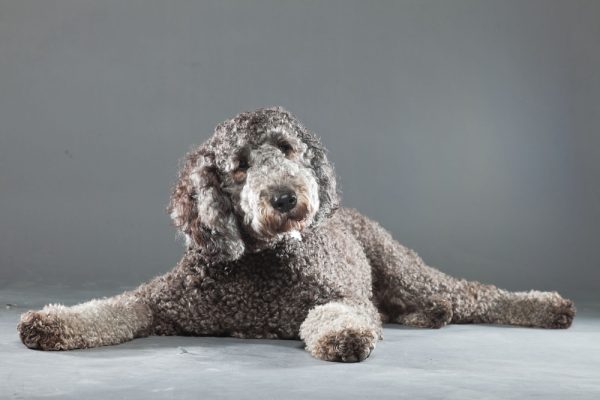Click to Skip Ahead
If you look at pictures of Labradoodles, one of the first things you’ll notice is how many different coat colors there are. You can find Labradoodles in apricot, cream, black, chocolate, chalk white, and silver among others because the Poodle—one of the two parent breeds along with the Labrador Retriever—comes in so many different colors.
A silver/gray Labradoodle is a sort of ashy gray shade, and this may present on its own or in conjunction with another color like beige or with a black or white mask, points, or markings. Silver is a less common Labradoodle coat color than some of the other possibilities, like chocolate.
In this post, we’ll break down when and where the Labradoodle originated and what they were developed for. We’ll also share some interesting Labradoodle facts so you can get to know your curly silver friend a bit better.
Breed Overview
Height:
14–24 inches (miniature to standard)
Weight:
15–65 pounds (miniature to standard)
Lifespan:
12–14 years
Colors:
Chocolate, caramel, red, cream, silver, parti, black, chalk white, apricot, café au lait, blue, beige, tan
Suitable for:
Active and loving families
Temperament:
Cheerful, fun-loving, affectionate, energetic, intelligent, playful, friendly
In addition to a diverse range of coat colors, Labradoodles come in all shapes and sizes. This is because there are three Poodle sizes, which are Miniature, Medium, and Standard. It’s possible for a Labradoodle to be as little as 14 inches tall if the parent Poodle was a Miniature Poodle, but those with Standard Poodle parents can grow up to 24 inches tall.
Labradoodle Breed Characteristics

The Earliest Records of Silver Labradoodles in History
Though it’s often believed that Labradoodles originated in the 1980s, the term “Labradoodle” was floating around back in the 1950s when a man called Donald Campbell described his Poodle Retriever mix, Maxie, as such. In the 1980s, over in Australia, Wally Conron started breeding Labradoodles with the purpose of training them as guide dogs for the Royal Guide Dog Association of Australia.
The Poodle’s best traits—intelligence, exuberance, and sociability—and those of the Labrador Retriever—sturdiness, loyalty, and gentleness—were considered the perfect mix for developing this service and companion dog. They were also developed with the intention of producing a low-shedding breed that would be less likely to trigger allergies.
There are two types of Labradoodle. In addition to the standard Labrador Poodle mix, there is also the Australian Labradoodle, which is a Labrador Poodle Cocker Spaniel mix.
How Silver Labradoodles Gained Popularity
Conron’s 1980s breeding program was a success, with one of the first “official” Labradoodle puppies (Sultan) heading over to Hawaii to become a guide dog for a woman there. From this point, other breeders started to follow suit and the Labradoodle’s popularity quickly grew.
The Labradoodle’s fun and friendly personality coupled with their high intelligence and trainability drew a lot of attention, as did their low-shedding coats and diversity of size and coat color.
To this day, Labradoodles remain some of the most popular candidates for service and therapy training programs, which makes sense since both the Labrador Retriever and Poodle are also commonly involved in these programs.
Formal Recognition of Silver Labradoodles
The Labradoodle is not formally recognized by the American Kennel Club and other clubs because they’re a mixed breed—often referred to as a “designer breed.” However, the Labradoodle’s parent breeds—the Poodle and the Labrador Retriever—are both recognized.
The AKC formally recognized Poodles in 1887. Today, Poodles are ranked number seven on the AKC’s popularity rankings. Silver is listed as a standard color for Poodles, though not for Labrador Retrievers.
The Labrador Retriever was officially recognized a bit later, in 1917. There are only three standard Labrador colors: black, chocolate, and yellow. According to the AKC’s popularity ranking, as of 2023, they are the second most popular dog breed in America.
Does a Silver Labradoodle Make a Good Pet?
The Labradoodle’s delightful personality and family-friendliness are two of the reasons they’re so popular. Originally bred as service dogs, Labradoodles quickly also made their way into many homes as companion dogs because they have a tendency to get along well with everyone, including children and other dogs. They can also get along well with cats as long as both animals are gradually introduced to one another and are socialized together.
Though socialized Labradoodles are known for adapting very well to sharing a home with children, kids should learn how to approach and safely and gently interact with the Labradoodle.
Small children should always be supervised around the Labradoodle (though the same goes for any breed, small or large) to ensure nobody gets too overexcited. Labradoodles are very energetic dogs, and their bounciness may unintentionally knock an unsupervised little one over.
Top 3 Unique Facts About Silver Labradoodles
1. Three Coat Types Are Possible for Labradoodles
The two most popular coat types are the wool (curly) coat and fleece (wavy/shaggy) coat, which are low-shedding coats. On the other hand, the hair-coated Labradoodle sheds more, so these dogs are less popular with allergy sufferers.
2. Labradoodles Can Be Pretty Sensitive
These gentle dogs are known for having a sensitive streak because they become so devoted to their humans. This can lead to issues like separation anxiety if they don’t form positive associations around spending a certain amount of time alone from a young age.
3. Labradoodles Need Frequent Brushing
Though these dogs aren’t heavy shedders by any means, this doesn’t mean they never need brushing. A Labradoodle should be brushed with a pin or slicker brush a few times per week—more if necessary—to keep those lovely curls in check and get rid of dead hairs.

Summary
To recap, the silver Labradoodle descends from the trusty Labrador Retriever and the outgoing Poodle—a mix made in heaven. It’s no wonder these dogs are so sought-after.
If you’re considering becoming a Labradoodle parent yourself, we’d recommend checking out shelters and rescue organizations to see if any are up for adoption. There are even some organizations dedicated to rehoming Labradoodles, so you might want to have a look at what (and who) is out there.
See also:
Featured Image Credit: Studio_Shot, Shutterstock











